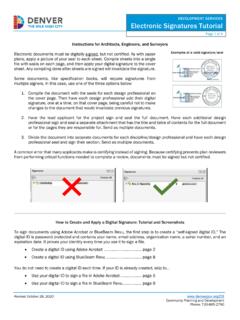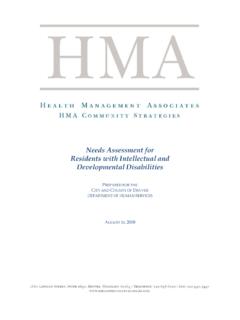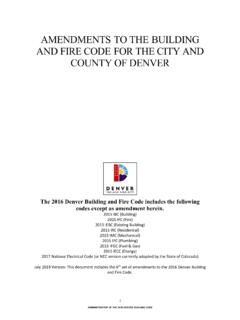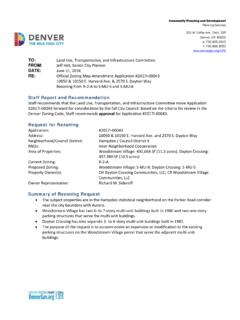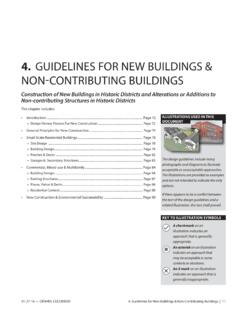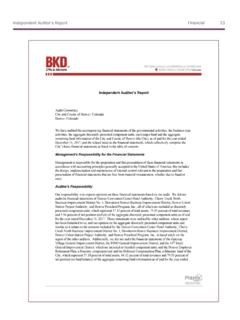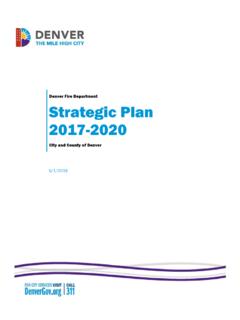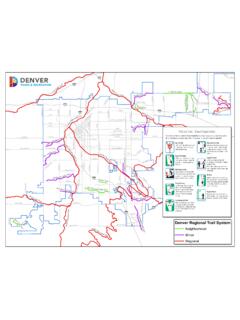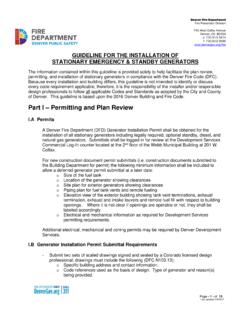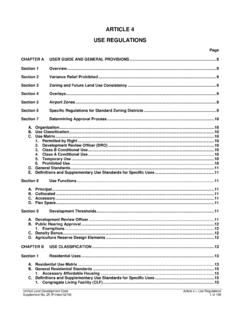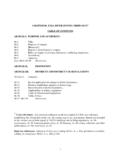Transcription of Article 6. GENERAL URBAN (G-) NEIGHBORHOOD CONTEXT
1 Article 6. GENERAL URBAN (G-) NEIGHBORHOOD . CONTEXT . this page left intentionally blank DENVER ZONING CODE. June 25, 2010 | Republished May 24, 2018. Contents Article 6. GENERAL URBAN (G-) NEIGHBORHOOD CONTEXT . DIVISION NEIGHBORHOOD CONTEXT DESCRIPTION.. Section GENERAL Character .. Section Street, Block and Access Patterns.. Section Building Placement and Location .. Section Building Height.. Section Mobility.. DIVISION DISTRICTS (G-RH-, G-MU-, G-RO-, G-MX-, G-RX-, G-MS-).. Section Districts Established.. Section Residential Districts (G-RH-3, G-MU-3 to -20, G-RO-3, G-RO-5).
2 Section Mixed Use Districts (G-MX-3).. Section Residential Mixed Use Districts (G-RX-3, -5).. Section Main Street Districts (G-MS-3, -5).. DIVISION DESIGN STANDARDS .. Section GENERAL Intent.. Section Building Form Intent .. Section Primary Building Form Standards .. Section Detached Accessory Building Form Standards.. Section Supplemental Design Standards .. Section Design Standard Alternatives.. Section Design Standard Exceptions.. Section Reference to Other Design Standards.. DIVISION USES AND REQUIRED MINIMUM PARKING.. Section Applicability.. Section Organization - Summary Use and Parking Table.
3 Section Explanation of Table Abbreviations.. Section District Specific Standards .. DENVER ZONING CODE | TOC-i June 25, 2010 | Republished May 24, 2018. this page left intentionally blank TOC-ii | DENVER ZONING CODE. June 25, 2010 | Republished May 24, 2018. Article 6. GENERAL URBAN NEIGHBORHOOD CONTEXT Division NEIGHBORHOOD CONTEXT Description Division NEIGHBORHOOD CONTEXT DESCRIPTION. Section GENERAL CHARACTER. The GENERAL URBAN NEIGHBORHOOD CONTEXT is characterized by multi-unit residential uses in a variety of build- ing forms. Single-unit and two-unit residential uses are also found in a mix of residential building forms.
4 Low-scale commercial areas are embedded within residential areas. Commercial uses occur in a variety of building forms that may contain a mixture of uses within the same structure. Residential uses are primarily located along local and residential arterial streets. Commercial uses are primarily located along mixed-use arterial and main streets but may be located at or between intersections of local streets. Section STREET, BLOCK AND ACCESS PATTERNS. The GENERAL URBAN NEIGHBORHOOD CONTEXT consists of a regular pattern of block shapes surrounded by an orthogonal street grid.
5 Orthogonal streets provide a regular pattern of pedestrian and vehicular connections through this CONTEXT and there is a consistent presence of alleys. Block sizes and shapes are consistent and include detached sidewalks, tree lawns, street and surface parking, and landscaping in the front setback. Section BUILDING PLACEMENT AND LOCATION. Residential buildings typically have consistent, shallow to moderate front setbacks, shallow side setbacks and consistent orientation. Commercial buildings typically have consistent orientation and shallow front setbacks with parking at the rear and/or side of the building.
6 Section BUILDING HEIGHT. The GENERAL URBAN NEIGHBORHOOD CONTEXT is characterized by moderate to high residential buildings and low to moderate commercial and mixed use structures in appropriate locations to promote a dense URBAN charac- ter. Lower scale structures are typically found in areas transitioning to a less dense URBAN NEIGHBORHOOD . Section MOBILITY. There is a balance of pedestrian, bicycle and vehicle reliance with greater access to the multi-modal transpor- tation system. DENVER ZONING CODE | June 25, 2010 | Republished May 24, 2018. Article 6. GENERAL URBAN NEIGHBORHOOD CONTEXT Division NEIGHBORHOOD CONTEXT Description this page left intentionally blank | DENVER ZONING CODE.
7 June 25, 2010 |Republished May 24, 2018. Article 6. GENERAL URBAN NEIGHBORHOOD CONTEXT Division Districts Division DISTRICTS (G-RH-, G-MU-, G-RO-, G-MX-, G-RX-, G-MS-). Section DISTRICTS ESTABLISHED. To carry out the provisions of this Article , the following zone districts have been established in the GENERAL URBAN NEIGHBORHOOD CONTEXT and are applied to property as set forth on the Official Map. GENERAL URBAN NEIGHBORHOOD CONTEXT G-RH-3 Row House 3. G-MU-3 Multi Unit 3. G-MU-5 Multi Unit 5. G-MU-8 Multi Unit 8. G-MU-12 Multi Unit 12. G-MU-20 Multi Unit 20. G-RO-3 Residential Office 3.
8 G-RO-5 Residential Office 5. G-MX-3 Mixed Use 3. G-RX-3 Residential Mixed Use 3. G-RX-5 Residential Mixed Use 5. G-MS-3 Main Street 3. G-MS-5 Main Street 5. Section RESIDENTIAL DISTRICTS (G-RH-3, G-MU-3 TO -20, G-RO-3, G-RO-5). GENERAL Purpose A. The intent of the Residential districts is to promote and protect higher density residential neighborhoods within the character of the GENERAL URBAN NEIGHBORHOOD CONTEXT . These regula- tions allow for multi-unit districts with a variety of residential building forms. B. The building form standards, design standards, and uses work together to promote safe, active, pedestrian-scaled residential areas.
9 The standards accommodate the pattern of URBAN house, duplex, row house, garden court, and apartment. Buildings orient to the street and access is from the alley. Lot coverage is typically high accommodating a consistent, shallow front yard. C. These standards recognize the variation within the GENERAL URBAN NEIGHBORHOOD CONTEXT and provide eight Residential Zone Districts. The lowest-scale districts with a maximum height of three stories provide a transition to URBAN and URBAN Edge NEIGHBORHOOD Contexts. The highest-scale districts with a maximum height of 12 and 20 stories promote a dense, URBAN residential character where appropriate.
10 The Residential Office (RO) districts provide opportu- nities for residential and offices uses in low to moderate scale residential building forms. D. The regulations provide certainty to property owners, developers, and neighborhoods about the limits of what is allowed in a residentially-zoned area. These regulations reinforce desired patterns in existing neighborhoods and create standards for new neighborhoods. Specific Intent A. Row House 3 (G-RH-3). G-RH-3 is a multi unit district allowing URBAN house, duplex, and row house building forms. Row houses are not taller than three stories.
